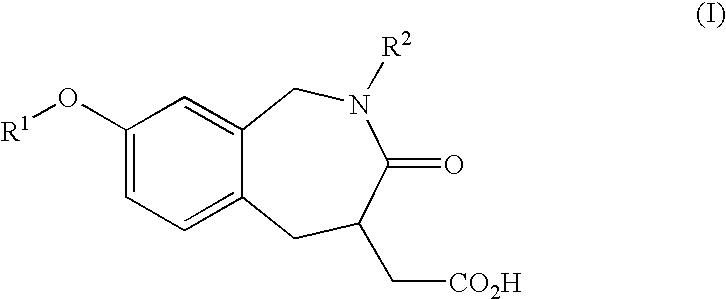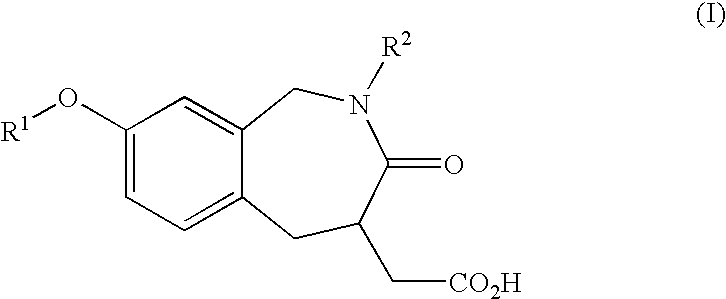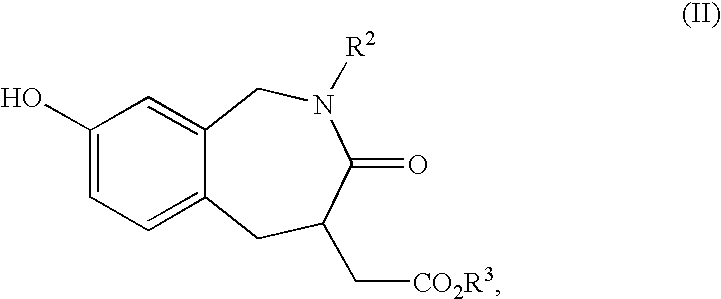Process and intermediates for preparing benzazepines
a technology of benzazepine and intermediates, which is applied in the field of process and intermediates for preparing benzazepine compounds, can solve the problems of high cost of reagents and large number of steps
- Summary
- Abstract
- Description
- Claims
- Application Information
AI Technical Summary
Problems solved by technology
Method used
Image
Examples
example 1
6-Bromo-3-hydroxybenzaldehyde
[0146] 3-Hydroxybenzaldehyde (120 g, 0.98 moles) was suspended in 2400 mL of CH2Cl2 in a 5 L 4-neck round bottom flask equipped with overhead stirrer, temperature probe, addition funnel, and condenser. The mixture was heated to 35-40° C. in order to dissolve the starting material. Bromine (52 mL, 1.0 moles, 1.02 eq.) was added dropwise through the addition funnel at a rate which maintained the reaction temperature between 35-38° C. The mixture was then allowed to stir overnight at 350 C. The mixture was slowly cooled to −5-0° C. over two hours and then allowed to stir at that temperature for 1 h more. The solid which formed was then collected by filtration through a Buchner funnel and the filter cake washed with 400 mL of a cold 1:1 CH2Cl2:heptane solution. The gray solid was then dried in vacuo (0.2 mm Hg) at room temperature. Yield=124.3 g (63%).
example 2
2-[(2-Formyl-4-hydroxyphenyl)methylidene]succinic acid
[0147] 6-Bromo-3-hydroxybenzaldehyde, 50 g, (from Example 1) was dissolved, with stirring, in 200 mL MeOH in a 500 mL Erlenmeyer flask. The resulting solution was filtered using a Buchner funnel lined with a glass microfibre filter. The filtered solution was charged into a 2 L 3-necked round bottomed flask, equipped with an air-driven mechanical stirrer, thermometer and reflux condenser, and stirred at room temperature for 2 hours. After confirmation by 1H-NMR that the dimethyl acetal is completely formed, Et3N (111 ml) was added to the reaction flask followed by 500 mL CH3CN. The reaction mixture was purged with N2 followed by addition of 32.5 g itaconic acid, 0.56 g Pd(OAc)2, 2.3 g P(o-tolyl)3 and 8.0 g Bu4NBr. The resulting reaction mixture was heated to reflux for 10 hours. After cooling to room temperature, about 550 mL of the reaction solvent was removed by rotary evaporation. Aqueous KOH solution (30 g in 200 mL water) wa...
example 3
(S)-2-Carboxyl-4-[(2-formyldimethylacetal-4-hydroxyphenyl)]butyric acid, bis(dicyclohexylamine) salt
[0148] 2-[(2-Formyl-4-hydroxyphenyl)methylidene]succinic acid (Example 2) (50 g, 0.20 moles) was dissolved by heating in refluxing MeOH(450 mL) in a one liter three neck flask equipped with a condenser and an internal thermocouple. After 4 h at reflux, the solution was cooled to ambient temperature and filtered through Whatman #1 filter paper. The filtrate was placed in a 2 L Paar bottle and DCA(84 mL, 0.42 moles, 2.1 eq.) was added, followed by water(50 mL), and [RuCl2(R-BINAP)]2-TEA(250 mg, 0.5 wt %). The bottle was then placed in a Paar shaker and filled with 60 psi H2, then evacuated. This fill and evacuate sequence was repeated twice more. The bottle was then filled with H2 to 60 psi a fourth time and shaking commenced. The contents of the bottle were heated to 60° C. and the reaction monitored by 1H NMR. After 36 h the reaction was complete as determined by the presence of 3CN(...
PUM
| Property | Measurement | Unit |
|---|---|---|
| temperature | aaaaa | aaaaa |
| pH | aaaaa | aaaaa |
| volume | aaaaa | aaaaa |
Abstract
Description
Claims
Application Information
 Login to View More
Login to View More - R&D
- Intellectual Property
- Life Sciences
- Materials
- Tech Scout
- Unparalleled Data Quality
- Higher Quality Content
- 60% Fewer Hallucinations
Browse by: Latest US Patents, China's latest patents, Technical Efficacy Thesaurus, Application Domain, Technology Topic, Popular Technical Reports.
© 2025 PatSnap. All rights reserved.Legal|Privacy policy|Modern Slavery Act Transparency Statement|Sitemap|About US| Contact US: help@patsnap.com



